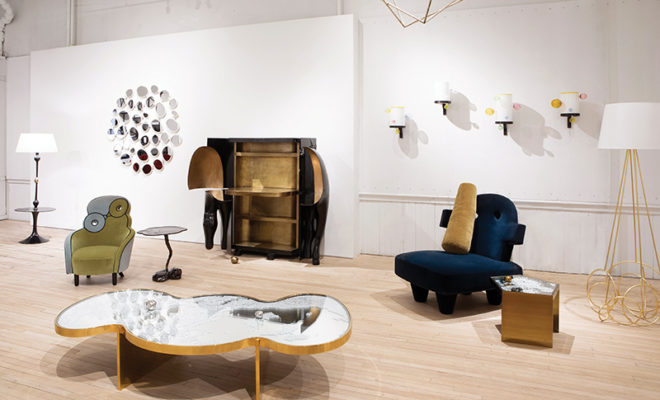 Le Gall’s work on view in a recent exhibition at Twenty First Gallery in New York. COSTAS PICADAS PHOTO, COURTESY OF TWENTY FIRST GALLERY.
Le Gall’s work on view in a recent exhibition at Twenty First Gallery in New York. COSTAS PICADAS PHOTO, COURTESY OF TWENTY FIRST GALLERY.
Exhibition
French Twist
HUBERT LE GALL DESIGNS CHEERFUL furniture. Looking at one of his meticulously crafted pieces evokes a feeling of well-being, and almost invariably, a smile. His creations are the work of someone who enjoys what he’s doing, and meeting the artist in person bears this out. Showing visitors around his first solo US exhibition, at the Twenty First Gallery in New York City, Le Gall fondly recalls the experience of developing the concept behind each piece, citing inspirations that range from animals and nature to classical literature and famous painters. His work straddles the barrier between art and design, although he insists that design—that is, function—always takes priority. “If it functions,” Le Gall asks, “is it less art?”
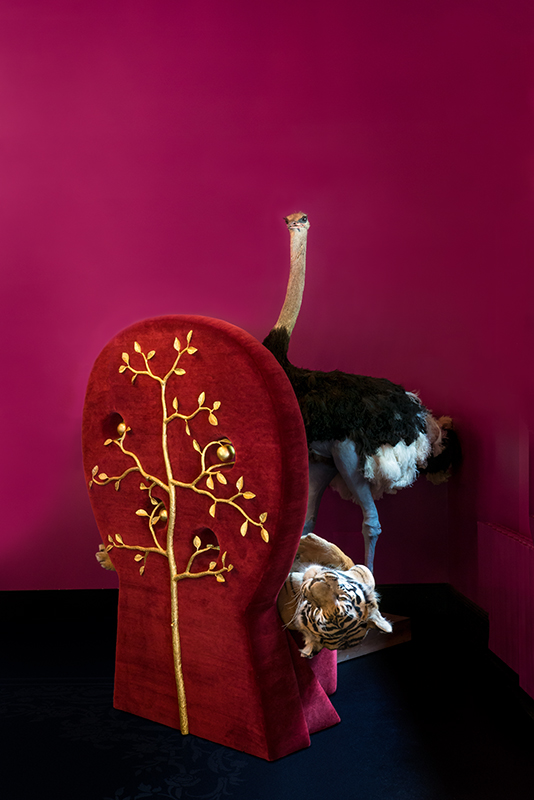
Eve armchair by Hubert Le Gall, 2017, as pictured in the new book Hubert Le Gall: Fabula. PHOTO © PASCALINE NOACK, COURTESY OF RIZZOLI.
Born in Lyon, France, in 1961 into a tradition-minded bourgeois family, Le Gall studied management and finance in school to please his parents, and art to please himself. He left his hometown in 1983 for Paris, where his first job was making films and books for an insurance company. That lasted for several years before Le Gall decided to follow his muse and make art. He began to paint, though found it frustrating at a time when video was, he says, the “hot new thing” and other mediums were considered passé. When someone suggested he could make furniture, Le Gall found that he moved easily from two dimensions to three. He enjoyed the hands-on work, and still today makes plaster models instead of sketching his designs. Le Gall also realized that making functional objects allowed him more creative freedom and easier communication with collectors—they don’t need to know what he was thinking in order to enjoy his designs. “With a painting, people feel they need to understand it,” he says. “When they buy furniture, people just care if it does what it should.”
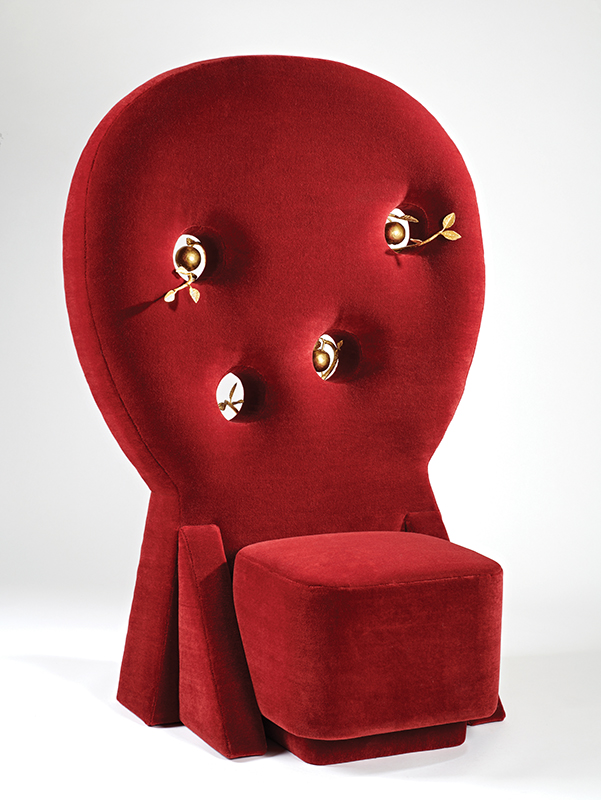
The Eve armchair from the front. EXCEPT AS NOTED, ALL IMAGES ARE BRUNO SIMON PHOTOS, COURTESY OF TWENTY FIRST GALLERY.
One thing furniture rarely does is make you laugh. But that’s the immediate response to several of Le Gall’s designs, such as his variation on the classic wingback chair in which the wings are attenuated to form rabbit ears, or his matching semicircular chairs with leaf-shaped upholstery that, when pushed together, form the shape of a flowerpot. But even that amusing design has, Le Gall says, a serious antecedent: it was inspired by Jean-Pierre Reynaud’s Le Pot doré, a gilded super-sized flowerpot sculpture created in 1985 on commission from the Cartier Foundation. The work of sculptor Henry Moore inspired his blocky Adam chair, Le Gall says, while Diego Giacometti’s inspired the gilt-bronze apple tree that grows up the back of his Eve chair. Surrealism prompted what Le Gall calls a “deconstructed mirror” that consists of interlinked, bronze-framed ovoid forms.

Hubert Le Gall in the Adam armchair, 2017.
Though he loves classical French furniture, Le Gall says: “I want to be of my own time.” In that vein, a macassar ebony commode faced with stylized lacquered-bronze flowers marries the spirit of Louis XVI’s renowned cabinetmaker André-Charles Boulle to Jean-Michel Basquiat. Le Gall’s best-known work is a bronze occasional table he designed in 1987 with a top of flower-shaped forms drawn from the blossoms in Andy Warhol’s 1964 silkscreen series Flowers. An immediate success, he made the table for many clients, in several different sizes, until three years ago. “The only place you can find one now is at auction,” he says with a laugh. “And for much more money.”
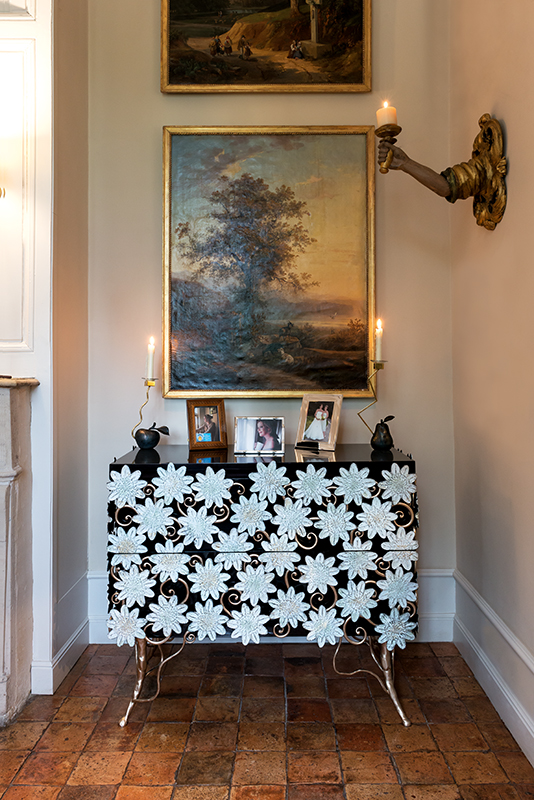
Anthémis chest of drawers, 1999, as pictured in Hubert Le Gall: Fabula. PHOTO © PASCALINE NOACK, COURTESY OF RIZZOLI.
Le Gall’s designs are produced either as one-offs, or in limited editions—in part because of their luxurious materials and painstaking fabrication. Apart from their elegant appearance and their felicitous air, Le Gall’s designs do not have a single distinguishing style. “After I make one thing,” he says, “I want to do something new—sometimes the opposite, but also sometimes the next logical step.” He admits that it’s challenging to stay on the line between creativity and excess: “Sometimes I go over the line.” But, he explains, “I am against ennui.” Indeed, his designs are anything but boring.

Pot de Fleurs chairs, 1998.
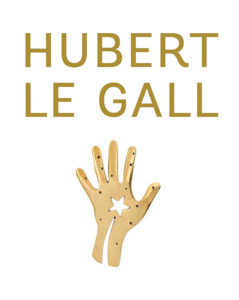
Hubert Le Gall: Fabula, recently published by Flammarion.
The opening of the exhibition in February coincided with the publication of an extravagant monograph from Flammarion. Fabula illustrates what the publisher calls “a love triangle” between collector Pamela Mullin, her seventeenth- century manor house in Normandy, and the Le Gall designs that fill its interiors. Many are specially commissioned works that reflect the collector’s eye and the artist’s most imaginative fantasies: furniture in the form of bison or horses; mantelpieces adorned with animal and foliage forms; a folding screen covered with stylized mice; and Pinocchio-nose lamps and tables.
Le Gall is a celebrated name in Europe, and his work has been shown at major international fairs, but his profile in America has stayed relatively low. Renaud Vuaillat, principal of Twenty First Gallery, Le Gall’s sole US dealer, says that’s due to change. Judging by the exhibition and book, his prediction is definitely on target.











